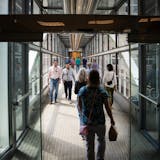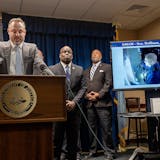The Minnesota Department of Transportation has stopped installing a smart warning system at rural intersections that alerts drivers to oncoming traffic, despite recent research touting its effectiveness in reducing fatal and serious injury crashes.
The agency has opted to abandon the system, in which a beacon flashes on both the major and minor road when drivers approach an intersection. MnDOT is opting to use its federal dollars to put in more traffic signals, roundabouts and J-turns — intersections where drivers are forced to make a right turn, go down several hundred feet to an opening in the median and make a U-turn before returning to the original intersection to complete their movement.
"We were hoping they would work," MnDOT traffic engineer Derek Leuer said of the Rural Intersection Conflict Warning System (RICWS). "We could not find they significantly reduced crashes."
The first RICWS in Minnesota arrived in 2013 to reduce right-angle crashes at intersections where minor roads are controlled only by a stop sign. MnDOT used federal grants over a six-year period to install the system at 56 intersections across the state. A sensor in the road triggers a beacon to flash to warn drivers of approaching traffic, and it stops flashing when it is safe to cross or turn onto the road.
Nearly two-thirds of crashes leading to serious injury or death in Minnesota happen at rural intersections, according to the Minnesota Department of Public Safety. Researchers at the University of Minnesota's HumanFirst Lab, the School of Public Health and Midwest Center for Occupational Health and Safety launched a study to learn how drivers interacted with RICWS to complement other studies they had partnered on with MnDOT.
Researchers analyzed crash data at all 56 intersections three years before and three years after RICWS went in. They found the system led to a year-over-year decrease in right-angle crashes, the most severe type of wrecks.
"The signs did work," said researcher Disi Tian, whose work was recently featured by the U's Center for Transportation Studies. "It takes time to take hold and capture a driver's attention."
The U study also suggested better-designed signs could make the system more effective.

![A black bear stopped after crossing Big Bay Road on Madeline Island, the largest of the Apostle Islands in Wisconsin, on Monday, May 31, 2021. ]](https://arc.stimg.co/startribunemedia/PWNYGIY3WTSWDBOGOYD775DPP4.jpg?&w=80&ar=1:1&fit=crop)

